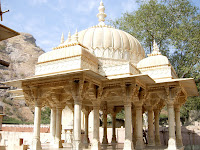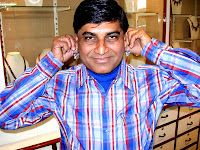 The next morning, Afsar drove us over to Fatehpur Sikr, a city built by the Mughal conqueror Akbar the Great in 1571 (son of Humayun). Intended to be the seat of his new government, Akbar only inhabited the city for 8 years before abandoning it due to lack of water. But the entire city is remarkable in its urban planning and well thought out design and architecture. Afsar quickly found us a trustworthy guide and sent us on our way to tour the city and learn its history.
The next morning, Afsar drove us over to Fatehpur Sikr, a city built by the Mughal conqueror Akbar the Great in 1571 (son of Humayun). Intended to be the seat of his new government, Akbar only inhabited the city for 8 years before abandoning it due to lack of water. But the entire city is remarkable in its urban planning and well thought out design and architecture. Afsar quickly found us a trustworthy guide and sent us on our way to tour the city and learn its history.
Afsar is a perfect example of a type of Indian that tries desperately hard to please his customers. Polite to a fault, he refused to name any price for his services, instead giving us the very Indian "as you like." "As you like" is actually extremely clever price structuring, as Westerners have generally very little idea of how much personally chauffeured tour services should cost and inevitably overpay whether out of a sense of guilt or aversion to seeming cheap, especially in the face of such squalor. (Plus, if you try to low-ball an Indian, they will shyly let you know that you're way out of their price range.) Afsar's mantra was, "If you are not happy, I am not happy" and insisted if we were dissatisfied, we could pay nothing. And honestly, I believe he lived by this creed. Every time I got in the car, Afsar made sure to open the door for me.
"Thanks," I would say.
"It is my pleasure." And it really was. It was his pleasure every single time he opened that damned door for me which, despite his best efforts, slowly ate at me. He would have done whatever it took to make us happy, which was maddening in its own way, but all on the assumption that we'll pay more if we trust and like our guide. And, of course, he's completely correct. A refreshing change from the street beggars of Delhi, you had to admire Afsar, working his way through graduate school (supposedly) and we completely wanted to make him happy.
Akbar was what they call a polymath--an amazing human being with a variety of skills and talents. He collected literature and art from around the world and invented the first prefabricated homes and movable structures (essentially invented the trailer park). He was also one of the first leaders to tolerate other religions and refrained from destroying Hindu temples during his reign, as well as hosting religious debates. Fatehpur Sikr completely reflects Akbar's tolerant attitude and inventive genius including early forms of plumbing and air conditioning in the middle of the desert.
Akbar had three wives: one Hindu, one Muslim, and one Christian. And he built separate places for all three within the city, the largest built for his favorite wife -- the Hindu. Akbar had this idea of uniting his people under one rule through religion, so he tried to create a fourth religion that combined elements of Hinduism, Islam, and Christianity with him as a sort of demigod figurehead called the Din-i-Ilahi or "Faith of the Divine". It didn't exactly catch on (any Akbarians in the house?), but you have to admire the guy for trying to unite factions that continued to bloody Indian soil over the next couple hundred years. Carved columns and other elements throughout the city have subtle nods to each religion weaving their symbols in connection with one another.
A couple other details worth noting: After five hundred years or so, you could still see flowers painted clearly on the walls -- sort of an early wallpaper. They looked charming, the kind of print one might have seen in the 1950s. Akbar also combined life-sized Parcheesi with music and dancing girls out in one of the entertainment squares. You can still see place designators carved into the marble floor. Akbar was also a fan of elephant fighting and has a tomb dedicated to one of his favorite elephants.
A main part of the city is a mosque called (as in Old Delhi) Jama Masjid. Despite three wives and many more concubines, Akbar had trouble conceiving. After a blessing by a Sufi Saint Salim Chisti, a wife bore him a male child, the later Emperor Jahangir. This saint has a beautiful tomb in the mosque where you're asked to "donate" some money to clothes for women and children by buying some cloth and red thread. In the mosque, you drape the cloth over the tomb and make up to three wishes tying each red thread on one of the tomb's window carvings. If you don't tell anyone, the spirit of Salim Chisti is said to make your wishes come true.
After an unmemorable lunch (many Indian guides seem to base their lunch and tour choices on other tourists' tastes unfortunately as we learned), Afsar insisted we go on a textiles tour, not coincidentally at his good friend's shop. Ah, here was the rub. I knew Afsar couldn't be completely clean; this was a common "scam" I had read about. We almost got sidetracked with a similar proposition in Delhi, but held our ground. Afsar being so nice, however, we relented.
Indian rug and jewelry dealers have selling down to a fine art. It's a cliche to say that Indian or Middle Easterners are the shrewdest bargainers in the world, but I was off the chart impressed. First they did give us a short tour of workers weaving thread through a loom chanting softly to each other so that they know where each other are in the process and to create a subtle working rhythm. The actually human labor that goes into a hand woven rug is so immense, we couldn't help but be impressed. Then our host took us back to the "dealership" where he had rugs that ranged from high end Mercedes to junky Hyundai. They had rugs of silk so soft you could drape them around your shoulders like a cape. And he was relentless. Telling us the prices weren't negotiable, he set to work and before we knew it Jean had a bought a lovely rug that they were shipping to Singapore. In hindsight we thought we may have been suckered a little too readily, but the reality is that these rugs cost a quarter of what they cost in New York. So even if Jean paid too much, she's still getting a great deal and a beautiful rug. Already having nice factory-made synthetic rugs, I declined over and over and over until the size of the carpet offered was no bigger than a doormat. But I held firm. We had fallen to the first of many Indian selling tactics.
Jean expressed some interest in seeing a similar marble shop, so we took a short tour on how craftsmen carve marble, but escaped with our wallets intact. We last went to Agra Fort, where Akbar moved after Fatehpur Sikri dried up. Agra Fort is an enormous structure built of red sandstone started by Akbar and finished by his grandson Shah Jihan, who built the Taj Mahal. Shah Jihan is said to have been imprisoned by his son in one of the towers for eight years where he looked out the window at the Taj Mahal, the tomb of his beloved.
We boarded our next train in the evening that would take us four hours west to the desert city of Jaipur in the state of Rajasthan.




















